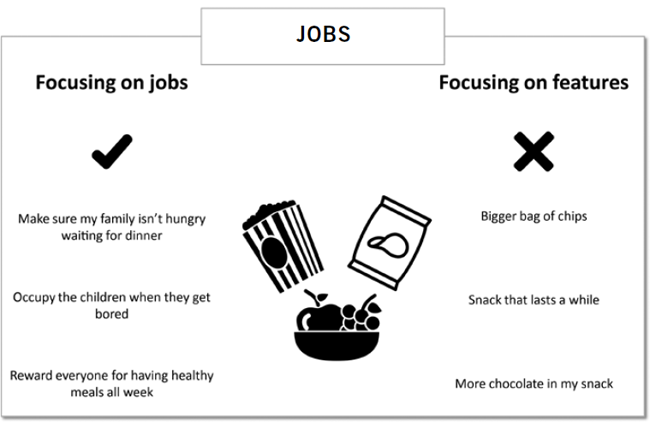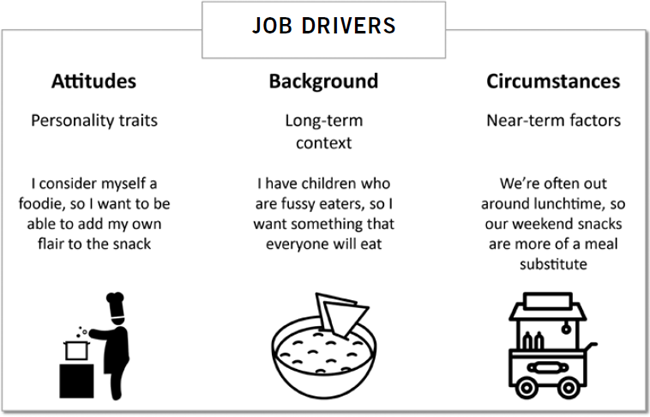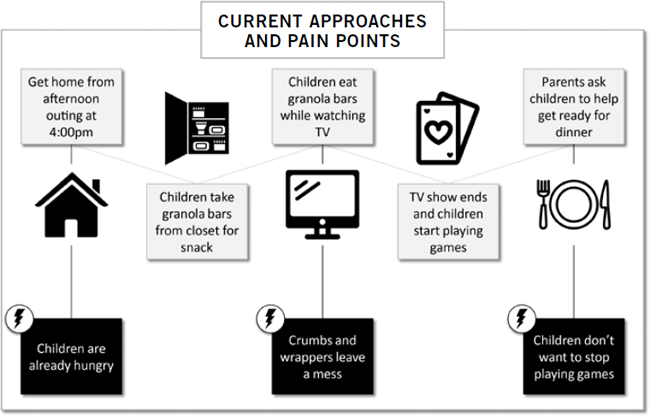 APPENDIX A
APPENDIX A 
QUICK REFERENCE GUIDE
As you conduct your primary research, this quick reference guide is meant to help you remember key points about each element of our framework. Once you’ve gathered your own insights, you’ll be able to analyze the patterns among your data points and ultimately build your own Jobs Atlas around specific customer types, occasions, or other opportunity areas. To clarify some of our key points, we’ve included examples based on hypothetical customer insights related to weekend snacking occasions for families. Remember that your findings will be highly dependent on context. As you’ll see even in our short example, these insights would change significantly if you were looking at different customer types or different consumption occasions. Also note that our examples are meant to be illustrative. They represent only a small snapshot of the insights you would expect to uncover by using our framework to engage in actual primary research.
![]()
REFRESHER POINTS:
![]() Jobs are the tasks that consumers are trying to get done in their everyday lives.
Jobs are the tasks that consumers are trying to get done in their everyday lives.
![]() Research needs to focus on uncovering consumers’ jobs, not just what they’re currently buying or what they think a good solution would look like.
Research needs to focus on uncovering consumers’ jobs, not just what they’re currently buying or what they think a good solution would look like.
![]() Look to satisfy both functional and emotional jobs.
Look to satisfy both functional and emotional jobs.
![]() While consumers will be looking to satisfy a number of jobs, some will be more important than others. Focus first on satisfying those “North Star” jobs.
While consumers will be looking to satisfy a number of jobs, some will be more important than others. Focus first on satisfying those “North Star” jobs.
![]() In your research, keep asking “why?” to make sure you understand the true underlying jobs.
In your research, keep asking “why?” to make sure you understand the true underlying jobs.
Example:
REFRESHER POINTS:
![]() Job drivers are the underlying factors that make particular jobs more or less important for different types of consumers.
Job drivers are the underlying factors that make particular jobs more or less important for different types of consumers.
![]() Job drivers can be uncovered by looking at three broad categories: attitudes, background, and circumstances.
Job drivers can be uncovered by looking at three broad categories: attitudes, background, and circumstances.
![]() Jobs and job drivers combine to yield customer segments—groups of customers who will buy and behave in similar ways.
Jobs and job drivers combine to yield customer segments—groups of customers who will buy and behave in similar ways.
![]() Rather than building fully loaded, one-size-fits-none products, new offerings should be targeted to specific customer segments by focusing on the jobs that are important to those specific consumers.
Rather than building fully loaded, one-size-fits-none products, new offerings should be targeted to specific customer segments by focusing on the jobs that are important to those specific consumers.
Example:
CURRENT APPROACHES AND PAIN POINTS
REFRESHER POINTS:
![]() The product purchaser is just one of several stakeholders who may need to be satisfied with your new offering. Consider whether there is an end user or other key decision maker who will need to be satisfied.
The product purchaser is just one of several stakeholders who may need to be satisfied with your new offering. Consider whether there is an end user or other key decision maker who will need to be satisfied.
![]() Current approaches are the range of activities that collectively represent a customer’s way of doing something. Pain points—a breeding ground for innovation—are the areas of difficulty, frustration, or inefficiency along the way.
Current approaches are the range of activities that collectively represent a customer’s way of doing something. Pain points—a breeding ground for innovation—are the areas of difficulty, frustration, or inefficiency along the way.
![]() Because context can affect which jobs are in play, remember to ask about specific occasions (not just average behavior), getting as detailed as possible.
Because context can affect which jobs are in play, remember to ask about specific occasions (not just average behavior), getting as detailed as possible.
![]() Consumers are often attached to their current approaches, so carefully consider how fast you can expect consumers to change their behavior if your solution requires such change.
Consumers are often attached to their current approaches, so carefully consider how fast you can expect consumers to change their behavior if your solution requires such change.
Example:
REFRESHER POINTS:
![]() Success criteria are not jobs but rather indications of whether a job has been satisfied.
Success criteria are not jobs but rather indications of whether a job has been satisfied.
![]() The success of a new product will often require homing in on particular occasions and contexts that are the most important to the customer.
The success of a new product will often require homing in on particular occasions and contexts that are the most important to the customer.
![]() To get started, try understanding what customers want more of, what they want less of, and where they’re seeking a balance.
To get started, try understanding what customers want more of, what they want less of, and where they’re seeking a balance.
![]() Your new solution may ultimately require making trade-offs. It’s perfectly acceptable to give up on features that matter to a limited number of customers as long as you excel along the dimensions that matter most to your targeted customer segments.
Your new solution may ultimately require making trade-offs. It’s perfectly acceptable to give up on features that matter to a limited number of customers as long as you excel along the dimensions that matter most to your targeted customer segments.
Example:
REFRESHER POINTS:
![]() Obstacles come in two forms: obstacles to adoption and obstacles to use.
Obstacles come in two forms: obstacles to adoption and obstacles to use.
![]() Obstacles to adoption are hurdles that limit a consumer’s willingness to buy an offering.
Obstacles to adoption are hurdles that limit a consumer’s willingness to buy an offering.
![]() Obstacles to adoption can be reduced by making it easy for people to learn about and try your new offering.
Obstacles to adoption can be reduced by making it easy for people to learn about and try your new offering.
![]() Obstacles to use are hurdles that get in the way of success, thereby limiting a customer’s likelihood of continuing to use a product, purchasing add-ons, or upgrading to newer versions.
Obstacles to use are hurdles that get in the way of success, thereby limiting a customer’s likelihood of continuing to use a product, purchasing add-ons, or upgrading to newer versions.
![]() Continuously acquiring a new customer base is often too costly to be sustainable, making it important to eliminate obstacles to use so that first-time buyers become repeat buyers.
Continuously acquiring a new customer base is often too costly to be sustainable, making it important to eliminate obstacles to use so that first-time buyers become repeat buyers.
Example:
REFRESHER POINTS:
![]() Understanding how much money is at stake with respect to a new solution requires framing markets in terms of jobs, not products.
Understanding how much money is at stake with respect to a new solution requires framing markets in terms of jobs, not products.
![]() A value-based pricing strategy that accounts for the unique or emotional jobs your offering satisfies can help you more accurately understand how expensive your solution can and should be.
A value-based pricing strategy that accounts for the unique or emotional jobs your offering satisfies can help you more accurately understand how expensive your solution can and should be.
![]() In addition to thinking about the value you’re offering the customer and other key stakeholders, your solution needs to bring in value for the organization. Consider whether your model allows you to sustainably capture value.
In addition to thinking about the value you’re offering the customer and other key stakeholders, your solution needs to bring in value for the organization. Consider whether your model allows you to sustainably capture value.
Example:
REFRESHER POINTS:
![]() Beyond your traditional or direct competitors, your offering also competes against other offerings that satisfy the same jobs.
Beyond your traditional or direct competitors, your offering also competes against other offerings that satisfy the same jobs.
![]() Because consumers will look outside your product category to satisfy their jobs to be done, familiarize yourself with the entire spectrum of direct and indirect competitors, and position your products accordingly.
Because consumers will look outside your product category to satisfy their jobs to be done, familiarize yourself with the entire spectrum of direct and indirect competitors, and position your products accordingly.
![]() By applying a Jobs-based lens, your broader view can also illuminate more avenues for growth.
By applying a Jobs-based lens, your broader view can also illuminate more avenues for growth.
![]() Areas of nonconsumption—the areas in which your competitors aren’t currently playing—can offer substantial potential, but they also carry some degree of risk.
Areas of nonconsumption—the areas in which your competitors aren’t currently playing—can offer substantial potential, but they also carry some degree of risk.
![]() Think about both traditional and nontraditional competitors in terms of your relative advantages, flexibility, and risk.
Think about both traditional and nontraditional competitors in terms of your relative advantages, flexibility, and risk.
Example:







